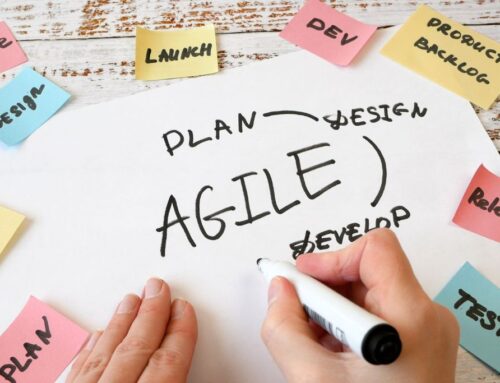In today’s rapidly changing business landscape, agility is no longer an option, but a critical imperative. From the financial sector to pharmaceuticals and public utilities to public services, organizations are recognizing the transformative power of agility. Agile transformation facilitates faster, higher-quality decision-making, improves product quality, expedites delivery, and boosts employee engagement. The potent combination of these outcomes can ultimately set organizations on a path to sustainable, transformational growth.
However, amidst the multitude of discourses centered on agile operating models, there is a critical aspect that often gets sidelined – the human element. A successful agile transformation requires not just the right vision, organization structure, tools, methodologies, and rhythms, but also the right people, equipped with the right capabilities. Agile transformations are just as much about people as they are about processes.
To fully leverage the agile potential, organizations must prioritize building capabilities. They must focus on developing talent with the right mindsets, behaviors, and skills, and empower them to make customer-centric, rapid, and cross-functional decisions.
Only when people are both skilled and empowered can an organization’s agile ‘body’ truly function at its best.
The journey toward agility demands commitment and effort from every member of the organization. Senior leaders must embody and inspire change, agile practitioners must innovate and meet evolving customer needs, and all employees must believe in and actively support the shift toward agility.
Building capabilities is not just about upskilling a select few. Rather, it is about fostering a culture of continuous learning, collaboration, and experimentation across the organization. Agile transformations are successful when they permeate every level of the organization, reaching every employee.

As organizations strive to shift from targeted agile experimentation to driving agility at scale, they face a critical challenge – developing and sustaining the infrastructure for capability building. This is not an easy task, especially in a competitive talent landscape where skill gaps are a significant obstacle to transformation.
Five guiding principles of agile transformation: Achieving strategic objectives
Based on our extensive experience with agile transformations, we have identified five guiding principles to help organizations build the required infrastructure and achieve their strategic objectives.
Strategic alignment of capability building with organizational priorities
The key to successful capability building lies in its alignment with the organization’s core strategic vision. The most successful organizations utilize a systematic approach, wherein their strategies and primary objectives shape their agile operating model, including their structure, processes, and technology. To put it more simply, individuals within an organization need to be adapted at performing the right tasks, at the right time, and in the right way – tasks that will generate value aligned with the organization’s strategic direction.
For instance, if an organization’s strategy is primarily centered around quickly delivering products and services to the market, the focus of capability building should be on enabling rapid solution deployment. Alternatively, if the strategy leans towards the development of innovative products, capability building should prioritize fostering customer empathy and honing design thinking skills.
Amplified investment in essential roles, skills, and mindsets for successful transformation
In alignment with the primary principle, organizations need to ensure that their workforce and their corresponding capabilities are fully in tune with the strategic direction of transformation. This often calls for the introduction of new talent, along with the upskilling or reskilling of existing employees. The journey towards an agile transformation, regardless of its magnitude, demands a harmonious collaboration of diverse roles and teams.
Effectiveness in this process requires a tailored approach with an intensified focus on those priority roles and skills that generate substantial value for the transformation. Leading institutions set their sights on deepening the capacity building for these pivotal roles early on, concurrently nurturing a wider awareness for the rest.
Key roles within this transformation include:
- Visionary senior leaders, who can cultivate both technical expertise (for instance, digital proficiency) and interpersonal abilities (such as leading with intent, not just the end goal).
- Agility mentors, who are tasked with building, coaching, and guiding teams, exemplifying desirable behaviors, and enabling leaders to spearhead organizational change.
- Product champions, who personify the mindset and behaviors needed to develop and deliver a persuasive user-focused product vision, engaging a variety of customer, business, and technology stakeholders.
- Community leaders, who foster communities of practice, set professional standards for distinct functional areas, and address talent development in a more fluid, less hierarchical organization.
- Other essential roles, like technology leaders, who cultivate tech talent and guarantee that the organization’s tech and data systems can realize the audacious vision of the transformation.
For the larger workforce, it’s crucial to grasp the rationale behind the organization’s shift towards increased agility, its implications for them, and their role in this transition. Organizations often engage this segment through a blend of decentralized outreach activities and centralized learning and knowledge-sharing platforms:
- Motivating town hall meetings (to drive purpose clarity)
- Continuous and self-directed learning opportunities (to disseminate knowledge extensively)
- Local forums and boot camps (to enhance capabilities, promote learning, and strengthen community)
- Learning communities (to disseminate knowledge and best practices, and foster continuity and institutionalization)
These pivotal roles serve as catalysts to facilitate these activities, educating and inspiring the wider employee population to embrace agile practices across the enterprise over time.
Harnessing tailored learning journeys for each role to foster meaningful behavior change
Behavioral transformation is no small feat; it’s a long-term endeavor that unfolds gradually via a multi-faceted network of interventions. These interventions are carefully crafted to reinforce learning, personalizing the journey to suit the unique needs of everyone. This strategy assumes even greater importance in the realm of agility, where teams are encouraged to learn and make decisions at an accelerated pace. Consequently, learning and development at the individual level must also foster an environment of practice, experimentation, continual iteration, and introspection.
In essence, fostering meaningful behavioral change requires a commitment to a tailored approach to capability building that is grounded in carefully curated learning journeys.
Setting and tracking measurable outcomes in capability-building endeavors
Assessing the impact of any capability-building program can indeed be a complex undertaking. However, successful organizations manage this by implementing a multi-tiered measurement approach:
- Reaction Metrics: These are used to measure a learner’s subjective evaluation of their learning experience. They help gauge the level of satisfaction, engagement, and perceived value for time invested in the program.
- Proficiency Metrics: These metrics help monitor improvements across various knowledge domains.
- Behavior Metrics: These assess the significant “from-to” shifts in behaviors exhibited by learners over time. The use of 360-degree feedback from various stakeholders can provide comprehensive behavioral insights.
- Business Metrics: These encompass both individual (such as retention, promotion, and evaluation metrics) and collective performance indicators (like improved productivity, accelerated time to market, and heightened profitability).
Typically, the first three types of metrics are integrated within the learning journey and measured recurrently. The final one—business metrics—is a bit more challenging to handle due to the difficulty in establishing clear causal links between capability-building efforts and business results. It necessitates a more long-term perspective to implement and track. Nonetheless, organizations can utilize these metrics to create correlations in performance over time by contrasting teams led by individuals who have undergone formal learning journeys with those who haven’t.
By adopting such a comprehensive approach to measurement, organizations can better understand the impact of their capability-building initiatives, thereby allowing for more strategic adjustments and enhancements in the future.
Building an organizational ecosystem for sustainable impact: the role of agile academies
For a transformative impact that stands the test of time, organizations need to focus on developing robust ‘organizational muscles.’ This process involves creating comprehensive learning journeys that align with evolving needs and developing an infrastructure that can sustain, enhance, and scale these programs over time. A proven strategy to achieve this goal is to establish an ‘Agile Academy,’ a dedicated initiative that aims to nurture the talent essential for driving transformation.
Without this robust infrastructure, organizations run the risk of allowing their curriculum to become obsolete, losing track of the progress and outcomes from their capability-building efforts, and missing crucial on-the-job development opportunities.
Reflecting on our experiences and observations, we identify a few key success factors that can contribute to successful implementation and operation of these Agile Academies:
- Garnering Top-Down Sponsorship: It is crucial to secure clear endorsement and buy-in from senior executives to ensure that the initiative receives the necessary resources and attention it requires to succeed.
- Encouraging Strong Collaboration: A collaborative environment among the agile center of excellence (where applicable), various business lines, and the learning and development team fosters synergistic relationships that drive success.
- Cultivating a Learning-Oriented Culture: Organizations need to cultivate a culture grounded in a growth mindset and nimble learning practices. This can include tactics such as A/B testing content and programs for rapid enhancement.
- Assembling the Right Team: The success of the academy relies heavily on the team behind it. It’s important to have a blend of faculty, such as agile coaches, instructional designers, learning architects, along with a strong program-management support system.
- Investing in Learning Technology: Utilizing advanced learning technology ensures flexible content consumption, like bite-size learning modules, and facilitates tracking of engagement and impact metrics.
- Integrating Learning Programs with HR Processes: Connecting the learning initiatives with core HR processes such as performance management and staffing can lead to more streamlined and effective operations.
- Implementing a Rigorous Certification Process: Rather than recognizing just the completion of training, a robust certification process acknowledges the demonstrated capabilities on the job, thereby adding more value to the learning journey.
The journey towards agility is a challenging yet rewarding endeavor. Building the right capabilities is an essential step in this journey, acting as the fuel that powers an organization’s agile body.
With focused efforts on capability building, organizations can not only navigate the path to agility but also unlock unprecedented growth opportunities. It might require substantial investment and time, but the rewards of agility – in terms of improved decision making, better products, faster delivery, and enhanced employee engagement – make the journey well worth it.


